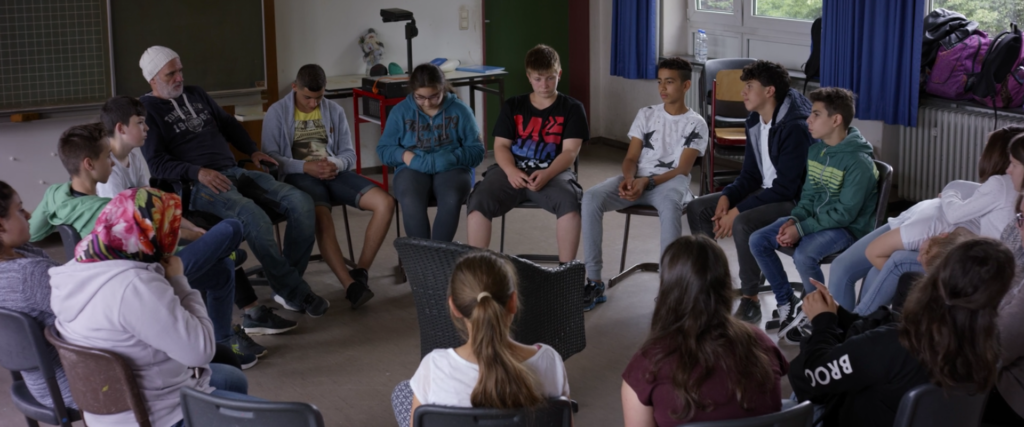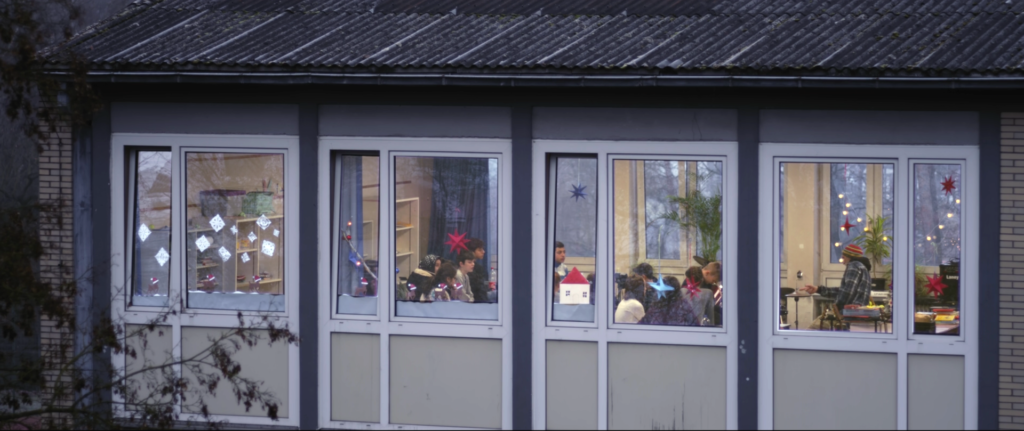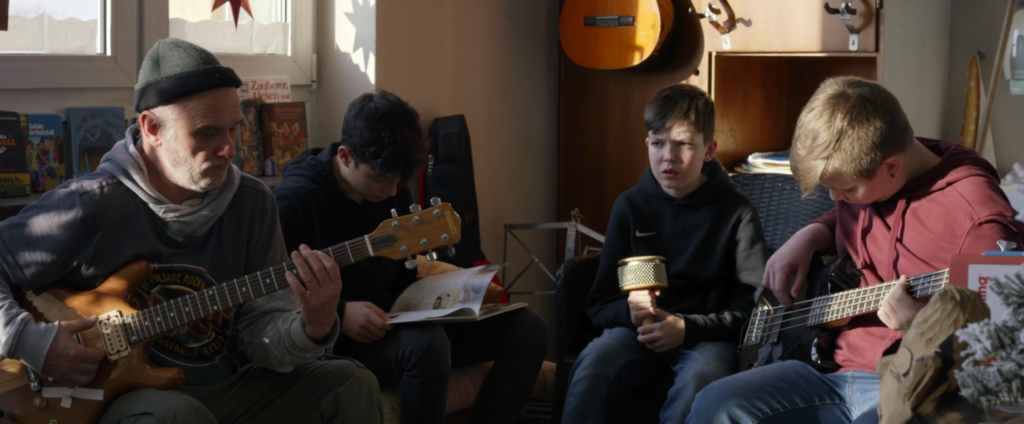
By Lina Shoumarova
June 23, 2022
Midway through the documentary Mr Bachmann and His Class, Dieter Bachmann, a teacher at the primary Georg Büchner School in Stadtallendorf, Germany, discusses his profession with a friend. Bachmann says that he resisted becoming a teacher at first because he had always felt alienated by the school as an institution. He constantly expected to be thrown out, he says, with laughter. He has thought about quitting, he admits, because of the feeling that “you can’t shape anything” and that you are fighting against the students. That’s not the kind of teacher, nor person, he wants to be, he observes. He doesn’t want to be “taming” the students, but to look for the meaningful moments in the learning process. Sometimes, he says, he feels like he should be “pushing them harder” and “doing more math and German,” but then he realizes that’s not the way he wants to teach—“just shoving things down their throats.” “It’s pointless,” he remarks. It’s working against the kids, not with them.
Relational pedagogy
This sums up Dieter Bachmann’s teaching philosophy. Having spent 17 years as a teacher, he understands that math and grammar are important but not as essential as reaching out to the human within and building a connection with the students as people. He lets his students find their own way—as much to the subject matter they are learning, as to who they are becoming as individuals.
What such a teaching philosophy requires is time. Learning takes time, and so does the process of figuring out who we are. It also takes time to build confidence, learn how to show who we are to those around us and live in community with others. Both Bachmann’s holistic pedagogical approach and the film allow for this kind of duration. At nearly three and a half hours, director Maria Speth’s documentary is an unhurried, in-depth observation of the dynamics of Bachmann’s classroom and his diverse group of students. They are teenagers, between 12 and 14 years old, many of whom have immigrated to Germany with their families from Turkey, Kazakhstan, Bulgaria, Italy, Morocco or are a second-generation immigrants. As the film unfolds, we gradually get to know them, as well as Bachmann himself.
As portrayed in the film, Bachmann shows intrinsic interest in his students and their lives. He instinctively understands the migrant experience (his paternal great-grandparents were Polish immigrants themselves) and he knows that for many of them it’s not easy to learn to live in a new culture and a new language. He also shows interest in his students’ families and home circumstances. In one scene in the film, we see him sitting together with the students’ parents after a class recital, sharing a meal with them and casually chatting and learning more about them.
Authenticity
The empathetic affinity he develops with his students also builds through the sharing of stories from his own life. He tells the story of his family’s name change from the Polish Kowalski to the German Bachmann. He also admits that he didn’t like spending time at home when he was growing up because of his parents’ alcohol problems.
With his woolen beanie hats, hoodies and rock-and-roll t-shirts, Bachmann evokes a sense of being an outsider himself. “So, all the gangsters are sitting at the back row,” he says at one point during the film, “I have to admit, I did the same thing when I was in school.”
The classroom as a safe space

One of the most remarkable aspects of the teaching and learning represented in this film is the classroom itself. It is a warm, sunlit space. As can be expected, it is also the stage of budding individualities and in the course of the film confrontations unfold between the students, we see moments of flirtation, vulnerability or the occasional grumbling when Bachmann asks them to do something they don’t want to. Overall, however, there is something very homelike about that room. The camera gives us a sense of brightness and spaciousness. The classroom is equipped with multiple musical instruments as well as a couch where the students can rest after class if they want to. This is a safe space where getting along with others in a small multicultural community is a possibility and where the young students can feel at home.
Music
Another important feature of Bachmann’s unconventional pedagogical approach is music. The universal language of music is an effective way to reach out to the kids. Using the variety of musical instruments in the classroom, Bachmann and the students form a makeshift band. We often see them jamming together to tunes such as “Smoke on the Water” by Deep Purple and Dolly Parton’s “Jolene”. He also encourages his students to sing, which for some of them becomes an outlet for self-expression.

Home, immigration and the relationship with the historical past
The classroom’s warm and convivial atmosphere relates to one of the central themes of the film—that of home. Of course, the idea of what constitutes homeland (Heimat in German) has troubled connotations in Germany. During a visit to the local museum, the students learn that Stadtallendorf has a long history of “guest workers” (gasterbeiters). During the Second World War, forced labourers, including children, were producing ammunition for the Third Reich in a secret plant in the city. In the present day, the camera has captured images of train tracks in disuse, overgrown with trees and foliage or paved over by a new construction of industrial buildings. History is still perceptible in material forms. The policy of bringing in foreign workers to Germany continues in more subtle ways, as we learn throughout the film that many of the students’ parents migrated to Germany seeking employment. We also briefly meet some of the other teachers in the school, notably Aynur Bal and Önder Cavdar, who were born in Germany, but whose families came from Turkey. The film is thus also a reflection on the impacts of migration and the quest for belonging that can extend over several generations.
Occasional establishing shots and landscape views throughout the documentary give us a sense of the city and the surrounding areas—fields, factories, mosques, small businesses, roads, housing complexes. This is the setting where the students and their families are making their new homes, even if, as the father of one of the students observes, it is culturally and socially very different from their homelands.
Open dialogue
In the classroom, Bachmann promotes open dialogue with his students. They talk about their experiences of immigration, feelings of nostalgia for their homelands and their struggle to deal with a sense of being outsiders in their new society and finding a sense of belonging.
Their discussions don’t shy away from topics that don’t always lead to consensus, such as gender relations at home, religious beliefs or finding romantic love. Sometimes Bachmann challenges the students’ prejudices and pushes their thinking, all the while remaining respectful of their cultural backgrounds. When a student says that he finds same-sex love “disgusting,” Bachmann asks him why he thinks that. He then invites the group to consider the perspective of another classmate: that what matters most is that the two people love each other.
Shared responsibility
On several occasions during the film, Bachmann appeals to the students who have strong language skills to help those who are just starting to learn German. “I think we should keep together as a class and help those kids who are struggling,” he says. Not all students are on board with this idea, however, as they don’t understand why they have to help a classmate who has received a low grade. But Bachmann persists in trying to make them see the importance of solidarity and shared responsibility: “I think we are a class and I’d really like to see us helping one another the best we can.”
Measuring progress
Knowledge of his students as full persons also informs how Bachmann sees their school performance. As mentioned above, he is particularly attentive to those students who are struggling to learn German and are falling behind. He repeatedly notes to the whole class—as well as to some of his colleagues—that it takes time for the students to feel comfortable with a language they don’t speak at home, and he appreciates the progress they have made for the short time they have lived in Germany. “You’ve only been in Germany for less than a year and you already write stories in German,” he says to one of them.
To Bachmann, seeing students building confidence in expressing themselves in a new language, speaking up in class or interacting with their classmates says more about their learning progress than grades. Yet, grading is how schools—and society—measure progress, and we learn in the film that the students’ grades can determine whether or not they would be placed in a more advanced stream in high school. At the end of the school year, as the students receive their final grades and as they are headed to the next stage in their school journeys, as well as in their lives, he tells them:
“These grades don’t reflect who you are at all. They are just a snapshot of kind of unimportant things like math and English. What’s much more important is that you’re all terrific kids and youngsters. You’re all really honest. Remain true to yourselves.”




